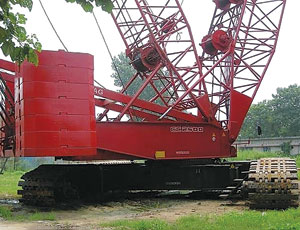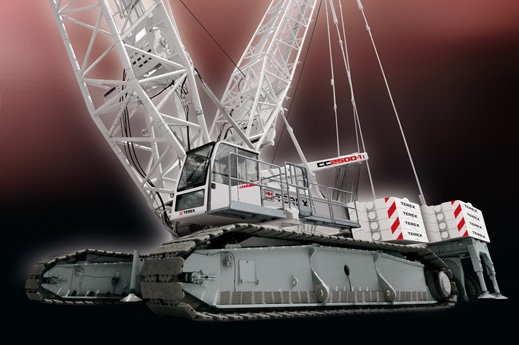 A fake Terex crane |
Equipment manufacturer Terex Corporation has fallen victim to intellectual property (IP) thieves in China after identifying a number of fake cranes being sold in the country.
Westport-based Terex recently identified eight counterfeit lattice boom crawler cranes in the Henan Province of China. The company says it is concerned the cranes being sold as used Demag models in China pose a safety risk.
The counterfeit cranes were labeled as Demag model CC2500. The original 500-ton cranes have been produced by Terex since 2001 and sell for USD3 million per unit.
Terex is not the only materials handling manufacturer to have its machines copied. German crane supplier Liebherr identified a fake model LR1280, normally a 300-ton crawler, in India last year. The purchaser was under the impression he had bought a second-hand crane but realised it was fake after trying to order spare parts based on the serial number. The number was a forgery.
Earlier this year, fake Tadano model cranes were identified near Jabel Ali seaport in the Middle East. Closer inspection revealed the cranes had been made in China. Tadano is a Japanese manufacturer of hydraulic and all-terrain cranes.
US-based Manitowoc also has concerns about counterfeit parts after it identified Asian companies building unlicensed mast and jib sections for its Potain tower cranes. The fake parts were almost identical to the originals, including designation and identification plate. The company has set up an internal task force to address the issue.
 A CC2500 Terex Demag Lattice boom crane |
Terex says although it is worried by the misuse of its brands and potential damage to its corporate image, the primary concern is with safety. The counterfeit cranes pose a safety hazard due to their mix of different design features and unmatched components.
Bonita Lewis Bell, Terex's chief intellectual property counsel, says the company has been concerned about IP theft for some time. "Most of the counterfeit machines identified are for in-country use, not for export, but a couple we have seen have been exported."
Bell says when a counterfeit is identified, Terex follows a standard process of working with the local authorities and the AIC, the Chinese authority equivalent to the US Trademark and Patent Office.
Besides counterfeits, she says Chinese competitors copy Terex's products and then brand them as their own. "There were similar issues in the '80s with the Japanese copying cars with a few added tweaks, bells and whistles," she comments.
Terex typically uses the civil approach to deal with breaches of IP. "You can go with administrative proceedings (which results in) fines and confiscation of items," Bell explains. "Because our product costs USD100,000-plus per unit, I would want to shut a company down, so I take civil action ..."
She says that as Asian countries move from "copier to innovator", their respect for intellectual property will increase in value.
The US Government's Department of Justice formed a taskforce on intellectual property in 2004 to co-ordinate international co-operation which it says is a critical component in "stemming the tide of global intellectual property theft".
The report recommends foreign governments should assist the US in its efforts to gather evidence and prosecute intellectual property criminals who violate its laws.
It identified several South East Asian countries such as China, Malaysia, Thailand, Taiwan, Indonesia and the Philippines as countries that do not adequately or effectively protect intellectual property rights.
The Department of Justice says it is waging the "most aggressive campaign against the theft and counterfeiting of intellectual property in its history".